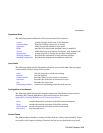Introduction
x-y This denotes a range of possible integer values.
text This denotes a character string of arbitrary length.
• Fields of type text can be selected by the field name but the text entry cannot be
matched.
If the text is a list of items, for example, a list of node names, the items in the list
may be separated by white space. A list of names, all of which share a common base,
for example, atlas0 atlas1 atlas2, may also be represented by a glob-like
expression, in this example, atlas[0-2]. The normal glob(7) expression syntax is
relaxed to include multiple digit numbers. For example, atlas[0-10,14]
represents the nodes numbered from atlas0 to atlas10 inclusive plus atlas14.
• Information on time is stored as UTC time in integer fields. Client programs should
convert time to local time and output the result as a string.
10.1.2 Access to the Database
There are three levels of access to the database:
1. Users can extract information from all of the tables but cannot update them.
2. Operators and administrators can extract information from all of the tables and, in
addition, update a limited selection of fields in some tables.
3. RMS itself can extract and update information in all fields of all tables. The
description of the tables in Section 10.2 includes information about which RMS
programs create and update each field.
10.1.3 Categories of Table
This chapter describes the tables in the database, listing them in alphabetical order.
This section groups the tables by category.
Configuration of Nodes
The following tables contain information about the individual nodes and about the
machine as a whole.
nodes describes the attributes of each node
node statistics contains performance statistics for each node
partitions defines each partition and its scheduling parameters
modules physical location and environmental data for each module
module types describes the characteristics of each supported module
10-2 The RMS Database


















